Catholic Customs
 |
 |
 |
 |
 |
 |
 |
‘Lady Day’ Gives a Rich & Sacral Legacy
The Feast of the Annunciation, also known as Lady Day, was always highly venerated in the Middle Ages when it was a holy day of obligation and was declared a public holy day by the civil authorities.
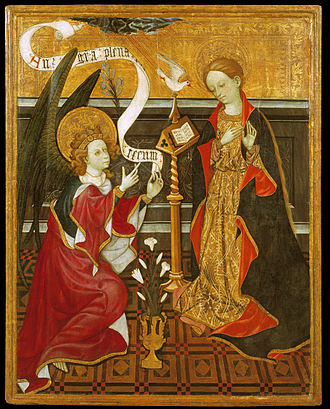 At the Council of Toledo (656) and the Council of Constantinople (692), it was declared that no feast days were to be celebrated during Lent except on Sundays and the Feast of the Annunciation. Dom Guéranger emphasizes that this feast day should be one of great joy reminiscent of the Christmas joy. (The Liturgical Year, vol. 5, p. 454).
At the Council of Toledo (656) and the Council of Constantinople (692), it was declared that no feast days were to be celebrated during Lent except on Sundays and the Feast of the Annunciation. Dom Guéranger emphasizes that this feast day should be one of great joy reminiscent of the Christmas joy. (The Liturgical Year, vol. 5, p. 454).
It was traditionally believed that the Creation of the world, the Fall of Adam and Eve, the Sacrifice of Isaac, the Exodus from Egypt, the Incarnation, the Crucifixion and Death of Christ, and the Last Judgment all took place or will take place on March 25. What a sacred day this truly is! It should, therefore, be celebrated with a like solemnity.
The Feast Day began with a solemn Mass – called a Missa Aurea or “golden Mass” in the grand cathedral – in honor of the Blessed Virgin. This Mass was often followed by solemn processions and mystery plays.
In Germany, an elaborate play was performed with an altar boy dressed as the Archangel Gabriel. The boy would be lowered on a rope through a hole - the Holy Ghost Hole - in the roof of the Church. Suspended in the air, the boy would salute “Mary” with the words “Ave Maria.”
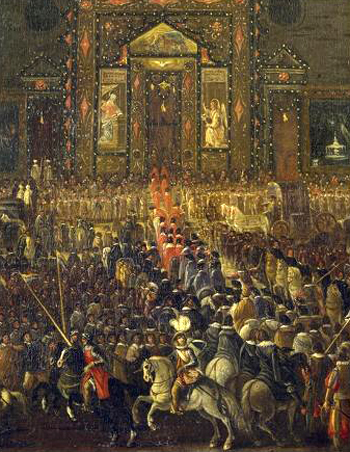 The city of Rome celebrated Lady Day with a magnificent procession from St. Peter’s to the Basilica of Santa Maria della Minerva. A beautifully decorated carriage drawn by six black horses was the throne of an image of the Blessed Virgin. Upon arrival the Pope would say a solemn Pontifical Mass, which was followed by a custom dear to the Roman people. Dowries provided by the Confraternity of the Annunciation were bestowed upon 300 young women so that they might marry well or enter convents.
The city of Rome celebrated Lady Day with a magnificent procession from St. Peter’s to the Basilica of Santa Maria della Minerva. A beautifully decorated carriage drawn by six black horses was the throne of an image of the Blessed Virgin. Upon arrival the Pope would say a solemn Pontifical Mass, which was followed by a custom dear to the Roman people. Dowries provided by the Confraternity of the Annunciation were bestowed upon 300 young women so that they might marry well or enter convents.
Thus the feast of the Incarnate Word inspired popular devotions and pious practices among a people who unconsciously understood that such practices were a means of making the Word become incarnate and ever-present in their daily lives.
So strong was the influence of the liturgical life on all of society that it was the custom of old for the papal Curia to begin the year on March 25 in all its communications and documents. This practice was adopted by civil governments for the legal dating of documents. The Feast of the Annunciation marked the beginning of the legal year in England even after the Reformation, up to 1752. Such natural customs are hard to erase, even after a people has been officially instructed in the unnatural separation of Church and State.
The secular & religious meet in customs
In a society imbued in all its aspects with the Catholic Faith, every animal, plant and natural object was believed to reflect the supernatural world in some way.
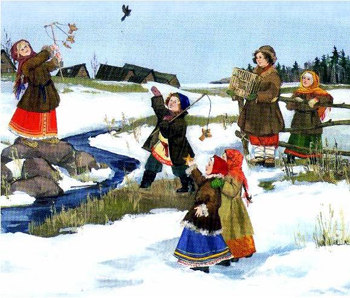
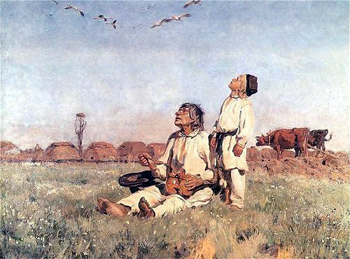 In Germany and other central European countries this day was often referred to as the "Feast of the Swallows." because it was believed that this was the first day the swallows returned from their winter migration.There is an old saying in Austria: “When Gabriel does the message bring, Return the swallows, comes the spring.”
In Germany and other central European countries this day was often referred to as the "Feast of the Swallows." because it was believed that this was the first day the swallows returned from their winter migration.There is an old saying in Austria: “When Gabriel does the message bring, Return the swallows, comes the spring.”
In Poland, this day was seen as the first day of the return of the storks, which were believed to bring good luck.
They called them “God’s birds,” in Hungary, “Mary’s birds” in Austria and Germany, and no farmer would ever kill swallows or destroy their nests. This impression deepened when Crusaders and pilgrims brought back descriptions of swallows that abounded in the town of Nazareth, the site where the Annunciation took place. (Francis Weiser, The Holyday Book, pp. 95-96)
In central Europe and Russia, this day was always richly connected with nature and the agrarian life.
Farmers in central Europe would return from Mass to perform their own ceremonies honoring the Blessed Virgin. The father of each family would place a picture depicting the Annunciation into his barrel of seed grain to bring a blessing on the coming sowing and harvest.
In Austria, they recited this prayer:
O Mary, Mother, we pray to you; Your life today with Fruit was blessed:
Give us the happy promise, too, that our harvest will be of the best.
If you protect and bless the field, a hundredfold each grain must yield.
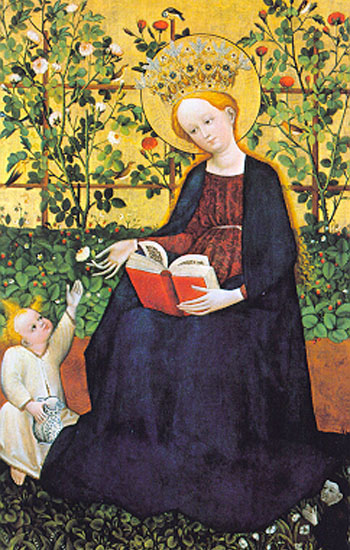 In Russia, after Mass priests would bless bread wafers that were distributed to every family. On returning home from Mass, the father of the house would tear small pieces of the bread wafer and solemnly present it the members of his family. Each one would receive the blessed bread with a bow and eat it silently. The leftover "Annunciation Bread" was crumbled and sprinkled on the fields to ensure a fruitful harvest.
In Russia, after Mass priests would bless bread wafers that were distributed to every family. On returning home from Mass, the father of the house would tear small pieces of the bread wafer and solemnly present it the members of his family. Each one would receive the blessed bread with a bow and eat it silently. The leftover "Annunciation Bread" was crumbled and sprinkled on the fields to ensure a fruitful harvest.
All this reflects a deep intimacy of man with God and His Holy Mother. It is something we have sadly lost today, the understanding that Christ wished to become incarnate in order to convince man of His friendship. Today, how few even think to beg God for a fruitful harvest.
What an ideal day this would be to plan vegetable and flower gardens for the year. If you have your seeds and starts for your garden, you could, like the Austrians, implore the blessings of Our Lady upon your crops.
How fitting also it would be to adorn Our Lady’s altar with flowers or plan a Mary Garden in her honor. Such gardens were common in the Middle Ages, when the people found a thousand tender reminders of Mary in the flowers around them: Lady’s mantle, Lady’s glove, Marigold.
A day of charity
The Annunciation, a day of such great joy, inspired the people to works of charity.
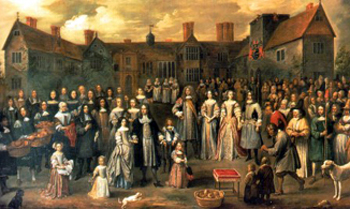 In Russia on the Feast of the Annunciation it was common to release prisoners from prison who had committed minor crimes and to send provisions to more serious criminals so that all could feel the joy of these days and experience Our Lady’s mercy.
In Russia on the Feast of the Annunciation it was common to release prisoners from prison who had committed minor crimes and to send provisions to more serious criminals so that all could feel the joy of these days and experience Our Lady’s mercy.
In England in the village of Tichborne, the poor people of Tichborne and two surrounding villages are given blessed food known as the 'Tichborne Dole,' a custom that began in the 12th century. The parish priest blesses the flour, and members of the Tichborne family distribute one gallon to every adult and half a gallon to every child.
This custom originated as the dying request of the Lady Mabella Tichborne to her husband. The request was accompanied by a curse upon the family should this generous dole be omitted on Lady’s Day. Here we see the charity that the feasts of the Church inspired in the highest members of society.
Special Annunciation dishes
If this day fell in Lent, the rigorous Lenten fast was partially suspended so that richer foods could be eaten. The Greeks, who were forbidden to eat fish or to consume olive oil and wine during Lent, were allowed to eat these foodstuffs on the Annunciation because of the grandeur of the feast. One traditional dish eaten in Greece on this day was Bakaliaros Tegantos kai Skordalia (Fried Salted Cod and Garlic Sauce).
 The word waffle in Swedish (Vaffla) is very similar to their term for the Virgin Mary (Var Fru), and so waffles with lingonberry preserves became the traditional Annunciation meal in Sweden. The crumbs of these Lady Day waffles would then be buried in the fields.
The word waffle in Swedish (Vaffla) is very similar to their term for the Virgin Mary (Var Fru), and so waffles with lingonberry preserves became the traditional Annunciation meal in Sweden. The crumbs of these Lady Day waffles would then be buried in the fields.
Another traditional food that developed in England was the Seed Cake, symbolic of Our Lord who became flesh as a seed in Mary's womb. It also represented the beginning of the Springtime planting season. The seed cake was circular to commemorate the beginning and closing of the year cycle, which began on March 25. Since tradition claimed it was also the date of the Crucifixion, this day began and also ended the cycle of Christ in the perfect symbolic circle.
Restoring customs
How can we celebrate this day in a way befitting of its grandeur? Like medieval man, we can start the day by attending morning Mass. Many homes and communities are restoring the solemn procession, led by the leading man of the community or the father of the family.
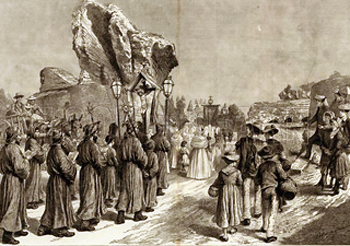
 Unfortunately, many modern families who are trying to restore these customs in their homes do so without the necessary sacrality and solemnity. With the adults and children casually and even immodestly dressed, the ceremony takes on a childish and even clownish air.
Unfortunately, many modern families who are trying to restore these customs in their homes do so without the necessary sacrality and solemnity. With the adults and children casually and even immodestly dressed, the ceremony takes on a childish and even clownish air.
With this in mind, let everyone be dressed properly (the men in suits and the women in modest dresses). Let the adults lead, with the children in the background so that they can learn to admire and respect the deeply sacral character of the liturgical life of the Church.
During the procession, a statue or image of Our Lady should be carried by the men on a richly decorated platform or throne. Live flowers blessed by holy water (especially the traditional Marigold, which medieval legend said adorned the dress of Our Lady), silk cloths, gems and precious jewelry could all adorn the statue.
The procession should lead to a prominent place in the home such as the family altar or place of prayer. If the family is a farming family, the procession can wind through the fields to ask Our Lady to bless the coming sowing and planting season. The procession should be followed with a lovely meal on a table adorned with flowers.
What once was true is always true: Let us as Catholics begin to restore the customs honoring the feast days of the Church and ask Our Lady’s blessing on our everyday work in the gardens and fields – even if we do not farm produce ourselves.
Let us ask Our Lady on her Day to help us regain our innocence and learn to understand that every action has meaning in the eyes of God, and that every joy and success we have – be it in business or simply a good meal – is owed to the mercy and goodness of God. Let us, then, honor the Blessed Virgin on her Feast Day so that we can give glory to God and receive rich blessings in our daily lives.
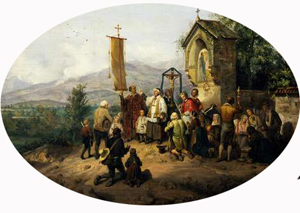

The Annunciation, or Lady Day, the most important Feastday in the early Church
It was traditionally believed that the Creation of the world, the Fall of Adam and Eve, the Sacrifice of Isaac, the Exodus from Egypt, the Incarnation, the Crucifixion and Death of Christ, and the Last Judgment all took place or will take place on March 25. What a sacred day this truly is! It should, therefore, be celebrated with a like solemnity.
The Feast Day began with a solemn Mass – called a Missa Aurea or “golden Mass” in the grand cathedral – in honor of the Blessed Virgin. This Mass was often followed by solemn processions and mystery plays.
In Germany, an elaborate play was performed with an altar boy dressed as the Archangel Gabriel. The boy would be lowered on a rope through a hole - the Holy Ghost Hole - in the roof of the Church. Suspended in the air, the boy would salute “Mary” with the words “Ave Maria.”

Annunciation procession in
the Piazza della Minerva in Rome
Thus the feast of the Incarnate Word inspired popular devotions and pious practices among a people who unconsciously understood that such practices were a means of making the Word become incarnate and ever-present in their daily lives.
So strong was the influence of the liturgical life on all of society that it was the custom of old for the papal Curia to begin the year on March 25 in all its communications and documents. This practice was adopted by civil governments for the legal dating of documents. The Feast of the Annunciation marked the beginning of the legal year in England even after the Reformation, up to 1752. Such natural customs are hard to erase, even after a people has been officially instructed in the unnatural separation of Church and State.
The secular & religious meet in customs
In a society imbued in all its aspects with the Catholic Faith, every animal, plant and natural object was believed to reflect the supernatural world in some way.

Russian children releasing swallows on Lady Day, below, Polish peasants awaiting the storks that migrate home on that day

In Poland, this day was seen as the first day of the return of the storks, which were believed to bring good luck.
They called them “God’s birds,” in Hungary, “Mary’s birds” in Austria and Germany, and no farmer would ever kill swallows or destroy their nests. This impression deepened when Crusaders and pilgrims brought back descriptions of swallows that abounded in the town of Nazareth, the site where the Annunciation took place. (Francis Weiser, The Holyday Book, pp. 95-96)
In central Europe and Russia, this day was always richly connected with nature and the agrarian life.
Farmers in central Europe would return from Mass to perform their own ceremonies honoring the Blessed Virgin. The father of each family would place a picture depicting the Annunciation into his barrel of seed grain to bring a blessing on the coming sowing and harvest.
In Austria, they recited this prayer:
O Mary, Mother, we pray to you; Your life today with Fruit was blessed:
Give us the happy promise, too, that our harvest will be of the best.
If you protect and bless the field, a hundredfold each grain must yield.

Our Lady in a garden of flowers that symbolize her virtues
All this reflects a deep intimacy of man with God and His Holy Mother. It is something we have sadly lost today, the understanding that Christ wished to become incarnate in order to convince man of His friendship. Today, how few even think to beg God for a fruitful harvest.
What an ideal day this would be to plan vegetable and flower gardens for the year. If you have your seeds and starts for your garden, you could, like the Austrians, implore the blessings of Our Lady upon your crops.
How fitting also it would be to adorn Our Lady’s altar with flowers or plan a Mary Garden in her honor. Such gardens were common in the Middle Ages, when the people found a thousand tender reminders of Mary in the flowers around them: Lady’s mantle, Lady’s glove, Marigold.
A day of charity
The Annunciation, a day of such great joy, inspired the people to works of charity.

A scene depicting the Ticheborne Dole in 1671
In England in the village of Tichborne, the poor people of Tichborne and two surrounding villages are given blessed food known as the 'Tichborne Dole,' a custom that began in the 12th century. The parish priest blesses the flour, and members of the Tichborne family distribute one gallon to every adult and half a gallon to every child.
This custom originated as the dying request of the Lady Mabella Tichborne to her husband. The request was accompanied by a curse upon the family should this generous dole be omitted on Lady’s Day. Here we see the charity that the feasts of the Church inspired in the highest members of society.
Special Annunciation dishes
If this day fell in Lent, the rigorous Lenten fast was partially suspended so that richer foods could be eaten. The Greeks, who were forbidden to eat fish or to consume olive oil and wine during Lent, were allowed to eat these foodstuffs on the Annunciation because of the grandeur of the feast. One traditional dish eaten in Greece on this day was Bakaliaros Tegantos kai Skordalia (Fried Salted Cod and Garlic Sauce).

The traditional Swedish waffles with lingonberry jam
Another traditional food that developed in England was the Seed Cake, symbolic of Our Lord who became flesh as a seed in Mary's womb. It also represented the beginning of the Springtime planting season. The seed cake was circular to commemorate the beginning and closing of the year cycle, which began on March 25. Since tradition claimed it was also the date of the Crucifixion, this day began and also ended the cycle of Christ in the perfect symbolic circle.
Restoring customs
How can we celebrate this day in a way befitting of its grandeur? Like medieval man, we can start the day by attending morning Mass. Many homes and communities are restoring the solemn procession, led by the leading man of the community or the father of the family.

A solemn Lady Day procession near Nice, France; below, a modern home procession lacking the sacrality of times past

With this in mind, let everyone be dressed properly (the men in suits and the women in modest dresses). Let the adults lead, with the children in the background so that they can learn to admire and respect the deeply sacral character of the liturgical life of the Church.
During the procession, a statue or image of Our Lady should be carried by the men on a richly decorated platform or throne. Live flowers blessed by holy water (especially the traditional Marigold, which medieval legend said adorned the dress of Our Lady), silk cloths, gems and precious jewelry could all adorn the statue.
The procession should lead to a prominent place in the home such as the family altar or place of prayer. If the family is a farming family, the procession can wind through the fields to ask Our Lady to bless the coming sowing and planting season. The procession should be followed with a lovely meal on a table adorned with flowers.
What once was true is always true: Let us as Catholics begin to restore the customs honoring the feast days of the Church and ask Our Lady’s blessing on our everyday work in the gardens and fields – even if we do not farm produce ourselves.
Let us ask Our Lady on her Day to help us regain our innocence and learn to understand that every action has meaning in the eyes of God, and that every joy and success we have – be it in business or simply a good meal – is owed to the mercy and goodness of God. Let us, then, honor the Blessed Virgin on her Feast Day so that we can give glory to God and receive rich blessings in our daily lives.

A priest blesses a family's fields in an Italian village

Posted March 24, 2020
______________________
______________________
 |
 |
 |
 |
 |
 |


